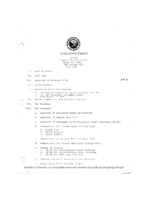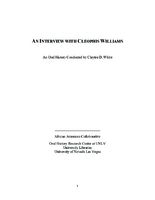Search the Special Collections and Archives Portal
Search Results
Do Stiver oral history interview
Identifier
Abstract
Oral history interview with Do Stiver conducted by Irene Arambula on March 17, 1978 for the Ralph Roske Oral History Project on Early Las Vegas. In this interview, Stiver discusses arriving to Las Vegas, Nevada in 1946 with her husband and recalls their involvement in numerous businesses. She then describes the Huntridge neighborhood and its development. Stiver later recalls the pollution emitted from the factories and the increase of smog in Henderson, Nevada.
Archival Collection
William Trent Jr. oral history interview
Identifier
Abstract
Oral history interview with William Trent Jr. conducted by Cathy Joseph on March 23, 1986 for the Ralph Roske Oral History Project on Early Las Vegas. In this interview, Trent discusses his family background, and his personal history in Las Vegas, Nevada. Trent then discusses his work as an electrical contractor, changes in Las Vegas as gambling increased, and he recalls the development of casinos on the Las Vegas Strip.
Archival Collection
Steve Bailey oral history interview
Identifier
Abstract
Oral history interview with Steve Bailey conducted by Dennis Berry on March 20, 1978 for the Ralph Roske Oral History Project on Early Las Vegas. Bailey talks about his education, the
Archival Collection
Ruth C. Norton oral history interview
Identifier
Abstract
Oral history interview with Ruth C. Norton conducted by Gary Melton on March 09, 1979 for the Ralph Roske Oral History Project on Early Las Vegas. In this interview, Norton discusses her arrival to Las Vegas, Nevada in 1959 to teach at an elementary school in Henderson, Nevada. Norton then discusses education curriculum, school athletics, and the overall state of education at the time. Later, Norton discusses adult education and special needs education.
Archival Collection
Alexander Nicholas oral history interview
Identifier
Abstract
Oral history interview with Alexander Nicholas conducted by Saleeh Sarwar Khan on February 24, 1980 for the Ralph Roske Oral History Project on Early Las Vegas. In this interview, Nicholas discusses the increase in population in Las Vegas, Nevada and describes the type of crime that is most common in the city. Nicholas also describes the increase in pollution as more factories were built. Lastly, Nicholas discusses general changes in Las Vegas.
Archival Collection

Meeting minutes for Consolidated Student Senate University of Nevada, Las Vegas, March 28, 1985
Date
Archival Collection
Description
Text

Video Interview with Jarmilla McMillan-Arnold at Vegas PBS, April 2, 2013
Date
Archival Collection
Description
Daughter of Dr. James McMillan, first black dentist in Las Vegas and a former NAACP president, recalls moving to Las Vegas from Detroit, learning about segregation here. She mentions list of outstanding female mentors and community leaders, and much more.
Moving Image

Video Interview with Melvin Sanders at Vegas PBS, April 1, 2013
Date
Archival Collection
Description
Melvin Sanders talks about growing up on the Westside as the son of a pastor/auto detailing business owner. He recalls tensions and the joy of his upbringing during the 1960s. He tells a story about working for State Gaming Board at age 16, going to college on a football scholarship, and an encounter with Sonny Liston. Sanders and his brothers inherited his father's auto detailing business.
Moving Image

Transcript of interview with Jarmilla McMillan-Arnold by Claytee D. White, October 7, 2010
Date
Archival Collection
Description
Jarmilla McMillan-Arnold’s father, Dr. James B. McMillan, was the first black dentist in the state of Nevada. Dr. McMillan’s colleagues consisted of Dr. West, the first black medical doctor in the state, and Dr. Ice, the first black surgeon in Nevada. This interview highlights and archives the solid foundation upon which Nevada’s black community was built. Jarmilla recalls early memories of growing up as the daughter of Las Vegas NAACP president Dr. McMillan. She was born in Detroit, Michigan, to a Caucasian and Indian mother who was a professional dancer. Jarmilla’s parents separated when she was very young and as a result she was raised by her paternal grandmother who owned a restaurant in Pontiac, Michigan. Jarmilla describes her grandmother as being well-known and highly regarded in the community where she maintained her business. Jarmilla attended Catholic schools in Detroit, Pontiac, and Las Vegas. Having moved to Las Vegas with her father, Jarmilla’s narrative offers keen insigh
Text

Transcript of interview with Cleophis Williams by Claytee White, April 27, 2010
Date
Archival Collection
Description
In 1943, Cleophis Hill Williams was a teenager visiting her mother who had moved to Las Vegas. For most of her young life she had lived with her parents in Muskogee, Oklahoma and Paul Spur/Douglas, Arizona. The same year that she visited Las Vegas, she met her future husband Tom Williams, with whom she had nine children, all born and raised on the Westside. Tom worked construction and built their first home on G Street. For Cleophis, she focused her life on raising her children and, whenever possible, finding some precious time to read.
Text
